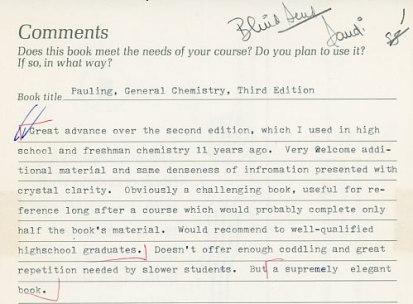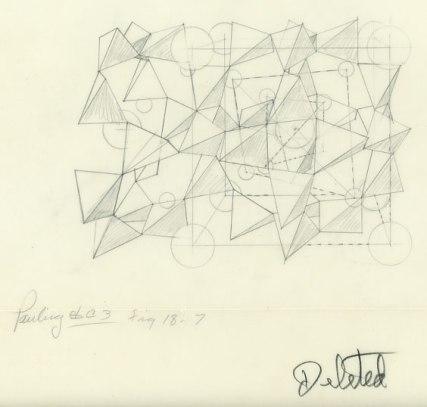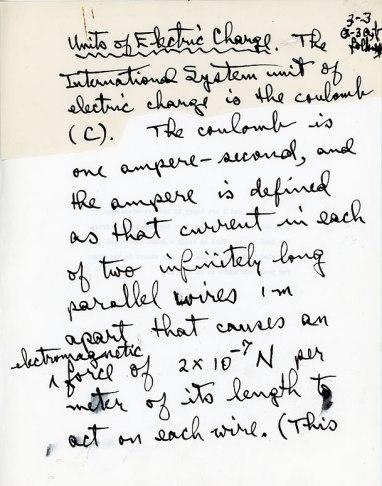
[An examination of General Chemistry, published by Linus Pauling seventy years ago. This is part 6 of 7.]
By the time that Linus Pauling was preparing to revise and publish a third edition of General Chemistry, the cast with which he had been working since the 1940s had shifted considerably. For one, publisher William H. Freeman had left Freeman & Co. in 1962, following the company’s merger with Scientific American. His secretary, Margaret Cooper, left the company with him, and the couple subsequently married that same year.
In 1964, the newlyweds started a new publishing house, Freeman, Cooper & Co., where a primary focus on science textbooks expanded to eventually include philosophy texts as well. At the time that he was creating this new company, Freeman, in a letter to illustrator and long-time collaborator Roger Hayward, outlined his sense of the continuing need for independent publishing houses as well as his own continuing interest in being involved with independent ventures of this sort.
Reading between the lines, one might conclude that the idea of associating with a corporation as massive as Scientific American had prompted Freeman to reevaluate his involvement with Freeman & Co. in much the same way that he had reevaluated his career at MacMillan almost twenty years before. Pauling, on the other hand, did not harbor similar misgivings – comfortable in his relationship with Freeman & Co., he opted to continue publishing with the firm even after the departure of his long-time editor and the company’s namesake.

Illustration proposed by Evan Gillespie for use in the third edition of General Chemistry.
Bill Freeman was not the only familiar face to be absented from the third edition; Pauling also chose to shift gears with his visuals. By the end of the 1960s, Roger Hayward’s illustrations no longer seemed satisfactory to Pauling, who wanted to experiment with stereoscopic drawings rather than sticking with Hayward’s more traditional style. Hayward had made an attempt at creating the kinds of three-dimensional images that Pauling was seeking but, by the time of the third edition, his struggles with chronic asthma and declining vision were both restricting his availability for projects and compromising his ability to create superior work.
In the end, Pauling decided to begin a new collaboration with Evan Gillespie, the director of the art department at Freeman & Co. Hayward, by now formally retired, continued to find commission work for the remainder of his life. He passed away in 1979 at the age of 80.
With Freeman and Hayward no longer in the picture, the core of Pauling’s new team consisted of illustrator Gillespie and editor Stanley Schaefer, who was also chairman of the Freeman & Co. board. Family played a significant role in the third edition as well, with Peter Pauling and Barclay Kamb – Pauling’s son-in-law – contributing intermittently throughout the project

Released in 1970, the third edition of Pauling’s General Chemistry focused more on physical and theoretical principles while – in response to a trend in comments expressed about the second edition – largely avoiding abstract mathematics. (Instead, he included more statistical mechanics.) Pauling also pruned what had been a longer section on descriptive chemistry and shortened his chapter on organic chemistry.
The question of how best to treat organic chemistry had presented a particularly vexing conundrum during the revision process. Pauling’s first edition had been criticized for providing only a surface treatment of the subject, but his expansion on the topic as presented in the second edition was met with even more criticism. For the third edition, Pauling worked to strike a balance on the subject, though some reviewers protested that he had failed to update his ideas sufficiently, rendering his new textbook at least partially out of date.
Generally speaking however, the third edition received a warm response. Most reviewers applauded Pauling’s switch to S.I. units, and the typically rigorous nature of the book – perhaps, by now, less of a shock within the academic community – elicited more positive praise than had been the case in the past. One reviewer specifically pushed back against complaints that the textbook was too difficult by noting that it was a professor’s responsibility to present Pauling’s subject matter with clarity and assistance when introducing it in the classroom. In other published reviews, Pauling’s clarity, unification of scientific principles, and modernity were emphasized.
Nonetheless, as time moved forward it became clear that more and more people were using General Chemistry as a reference book rather than a textbook. Pauling’s approach, revolutionary in 1947, had, by the early 1970s, become classic. As a new generation of chemists, many of them trained using General Chemistry, moved through the ranks of their profession, Pauling’s textbook assumed more of an artifactual positioning: solid in its place in history but increasingly less vital for students.
Importantly, Pauling had likewise moved on to a new phase of his career: in the same year that the third edition was released, so too was Vitamin C and the Common Cold. This book’s runaway success and the maelstrom of work and controversy that followed would consume much of Pauling’s attention for the remainder of his life.
Advertisements &b; &b;